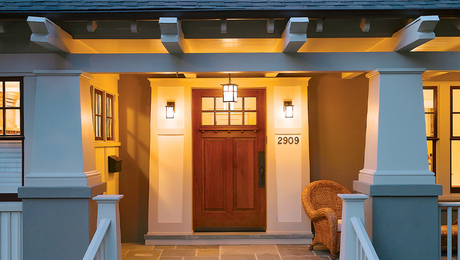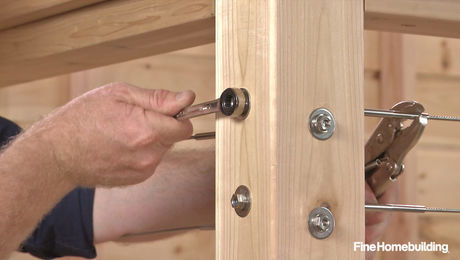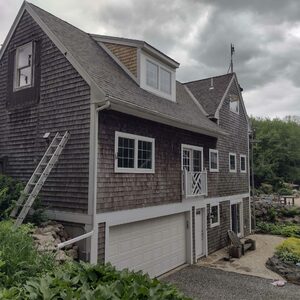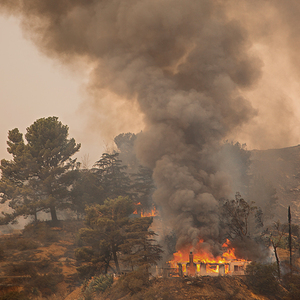Hmmmm. First attempt didn’t go so well. Found that the putty knife tended to stick to the compound giving it a ragged texture, rather than smoothly shaping it. Tried various angles of attack–no change. Need some oil on knife? Dap brand rather than Ace? Different technique?
Thanks.



















Replies
Wrong knife. Knife with a bent blade works very well, allows the portion of the blade following the bend to smooth the compound.
PAHS Designer/Builder- Bury it!
The type of knife doesn't matter at all. I prefer using a straight putty knife... it requires more of a skill though.
Do not oil the blade as it may affect the glazing compound and the abilty to ever paint it.
make sure that you are using a clean blade and that you have kneaded the glazing enough to make it smooth and elastic... it will flow wonderfully.
http://www.petedraganic.com/
The type of knife doesn't matter at all. I prefer using a straight putty knife... it requires more of a skill though.
Do you often contradict yourself like this?
PAHS Designer/Builder- Bury it!
how so?
One can use any type of knife... a straight putty knife or an angled knife designed specifically for glazing, for instance.
My preference does not mean you can't use another type of knife.
http://www.petedraganic.com/
I prefer a thin bladed flexible putty knife, but can use any. The angle at which it is held to the muntin and glass is most important to me.
Welcome to the Taunton University of Knowledge FHB Campus at Breaktime. where ... Excellence is its own reward!
Where is the contradiction in that? It wasn't a political statement!;)
Welcome to the Taunton University of Knowledge FHB Campus at Breaktime. where ... Excellence is its own reward!
Piffen,
1)type of putty knife doesn't matter at all
2) straight knife requires more skill-------
see how 2) contradicts 1)-----?
kind of nit-picky though --LOL---pretty sure it's just an hones typo/matter of semantics and that the world ain't gonna fall out of it's orbit
for the record--------i like Dap putty,straight flexible knife---long blade run // to glazing.--kneading VERY important---and I like to periodically wipe the blade with mineral spirits on a rag-----
Stuff in the tube is thinner,less body and more like tooling caulk
stephen
Well, the type of knife doesn't matter as in being able to complete the task... it answered the question of what kind of knife must be used.... not bearing upon the levele of required skill.
http://www.petedraganic.com/
Yes Pete--- i think on an issue of such mamoth importance as puttying a window
even you and I can agree to live and let live
especially since we are both using the same type of knife, LOL
Best wishes, Stephen
I guess U must have a mental block on that one.
Don't see any contradiction there at all. Sorry
Welcome to the Taunton University of Knowledge FHB Campus at Breaktime. where ... Excellence is its own reward!
Piffen,
I am going to really regret taking the lives of valuable electrons to make this pointless post---- LOL
but--------if If a straight knife requires more skill---that would seem to contradict a statement that the type of knife doesn't matter.
If they required the SAME amount of skill-then sure---probably doesn't matter.
Again- a descrepancy so innocuous that i should probably be banned from breaktime for even participating in this thread.
see what happens when there's not a decent" what's the best way to save the last 20% of a $4 tube of caulk?" thread to waste time on ?
Best to all, Stephen
I gotta say I agree with you Haz.
If a certain type blade requires more skill than the type of blade matters, especially to those that don't possess more skill!
I think that means me! LOL.
blueOur Skytrak is for sale. It has 500 hrs on it. We want 50k (you pay the freight) and we'll finance it. Drop me an email; it's a good buy.
If a certain type blade requires more skill than the type of blade matters, especially to those that don't possess more skill!
Which was the point of this whole thread- from a novice.
I've taught close to 2 dozen apprentices to putty divided lites in cabinet shops. Without exception they found the bent knife easier to initially master. PAHS Designer/Builder- Bury it!
What exactly is a bent knife. I meant to ask earlier but the thread got briefly sidetracked.
Do you mean an angled blade, curved blade or flexilbe blade bent under the pressure of the application mechanic?
blueOur Skytrak is for sale. It has 500 hrs on it. We want 50k (you pay the freight) and we'll finance it. Drop me an email; it's a good buy.
It has a bent blade that makes it easy to hold at just the right angle for novies. I think it is siold in paint supplies as a "Window tool" The opposite end of the handle has a straight blade
Welcome to the Taunton University of Knowledge FHB Campus at Breaktime. where ... Excellence is its own reward!
There's a better one that doesn't have a straight blade on the other end.
Blue, it looks like a thick blade straight knife but it's bent about 1.5" from the handle. Easier to use than a standard thin bladed knife. The one Piffin's talking about I'd leave in the store.
PAHS Designer/Builder- Bury it!
Nice to see a little passion about building techniques here at Breaktime again. Thanks to all of you for giving a damm.
If the window doesn't take much direct rain I like to use wooden stops ripped at the proper angle. Much faster and cleaner than glazing putty, easier to paint, remove or replace in the future. Who's the cat that won't cop out, when there's danger all about?
http://www.asmallwoodworkingcompany.com
jim, that'a an interesting idea( molding strips)
I don't know if I have ever seen a window---either the prime window or a storm window done that way---- EXCEPT----on tons of old wooden garage doors. Seems like they were ALL done that way
gonna have to think about that.
Stephen
Wooden stops work great, Stephen. An old window builder taught me that a few years ago. I buy my glass from his brother and was picking up several insulated units for a big old window I built for a friend. I was trying to remember what type glazing putty you're NOT supposed to use with insulated glass...something about compromising the seal if it's a certain type. So I ask him about it and he says "you're still using putty?! I switched to stops a long time ago! Try it, you'll never go back!"
As soon as he said it I recognized the merrit in what he was saying. "You owe me lunch!" he said as I grinned and jumped in my truck. I do, too. That has saved me a LOT of time and frustration ever since.
Hey, I liked your valley flashing article. Nice job.
Who's the cat that won't cop out, when there's danger all about?
http://www.asmallwoodworkingcompany.com
Jim,
extra bonus---now I get to buy a pin nailer----which will be Waaaaay more fun than buying a different putty knife LOL
If I keep my eyes open ----I bet I find more examples of this technique( new/old)---I remember the house I grew up in had mirrors inset into doors that way.
BTW---- my dad was an artist of the old school and used to cut his own mats, frame his own pictures---even build his own frames
I remember he had a little gismo that one edge would hook over the frame---and the other edge would drive a pin in the other side when you squeezed the handle. It's been maybe 35 years since I watched him use it--- I could still probably find it----but since his stroke he wouldn't be able to give me the " tutorial" I would probably like.
Stephen
That sounds like it might be the ticket. How do you attach them? A pin nailer or some adhesive?
How do you make it airtight?
Pin nailer, no glue, I want them removable.
They aren't airtight, not supposed to be. Paint them four sides before installation and pin them in. Any moisture that gets in the vertical joint between the stop and glass can run out the bottom. That's one thing I always try to design into any exterior details - give the water a chance to get OUT. Who's the cat that won't cop out, when there's danger all about?
http://www.asmallwoodworkingcompany.com
I agree with what you are saying about the water but there's got to be some airseal somewhere. Washington state isn't that warm. Do you seal the glass to the sash somehow?
Yeah, to the vertical face between the glass and the rabbit. Use either silicone or double faced glazing tape.
Don't forget to block up under insulated units, too, to avoid slippage that can compromise the seal over the years. Who's the cat that won't cop out, when there's danger all about?
http://www.asmallwoodworkingcompany.com
Hyde makes a knife designed for puttying windows...has a bent bade on one end, and a blade with a 90 degree fold on the other end (like a drywall corner taping knife.
It's made for the job....would you use a chop saw to rip wood?If I seem cranky..I am
20 posts here, & no one knows there's a tool made for the job?!?!
Wooo-heee! I have that knife, was looking for it to post a pic. A itty bitty notch in the folded end too. I did one of sashes last yr, and loved how that worked. That knife was lost in the shuffle for yrs, and magically re-appeared when I started on the glazing.
seems it got mislaid again.
Spheramid Enterprises Architectural Woodworks
Go away rain.
I have one of these too, but never knew what the original use was for. learned how to use a regular knife for glazing, can do it very well thank you.
what's the notch in the other end for (the folded/corner side)?
I have no earthly idea.
Spheramid Enterprises Architectural Woodworks
Go away rain.
The notched blade is a "cheater". Once the glazing has been pressed into place with the "spatula" end of the tool, you perform the finish stroke by running the notch along the outside shoulder to keep a consistant line. The downside of the tool is the rigidity and small surface area which make it harder to keep steady pressure into the corners, where the glaze is most likely to pull up.
Ah-ha!
My old frames are not nice crisp corners, been re-glazed over and over from the looks of them, that'd explain why I never figgured out the notch.
Spheramid Enterprises Architectural Woodworks
Shooting rubber bands at the Moon
would you use a chop saw to rip wood?
Only if I had a rip blade on it!
it's okay of your cranky. We give hugs out here nowadays. There does appear to be a shortage of journeyman glaziers though.
Which union trade governs them? Do they have their own specialty trade?
blueOur Skytrak is for sale. It has 500 hrs on it. We want 50k (you pay the freight) and we'll finance it. Drop me an email; it's a good buy.
Hee-hee
Still no power here, but I hear they're getting ready to throw the switch....many fingers crossed
I spent a few months replacing sash glass in a remodel..every two weeks, a trip to the local architectural salvage yard to pick up more bubble glass....
I got real good with a mini-butane torch, and a Hyde glaziers knife (and I happened to have a big antique Stanley glaziers chisel-not sure what made it a "glaziers" chisel, but it looked good ;-) )
Client had made a killing in the internet, liked the antique glass, and was getting a credit from the historical society for keeping the original divided light sash...
The knuckle-head painters kept getting sander scratches, or outright breaking, the new panes....
Probably lost a few IQ points inhaling lead paint fumes, but I can re-glaze & re-rope windows in my sleep now....too bad everyone wants cheap vinyl repacements
....too bad everyone wants cheap vinyl repacements
Not around here. The glass companies pay substantially for old (used) glass and still frequently run out. The HOs I've dealt with were more than happy to pay the price. History costs more. Complete with more air leaks and higher heating/cooling bills.
PAHS Designer/Builder- Bury it!
yeah, there is still some demand...
and if you look at the big picture, good double hungs with triple track storms can be pretty efficient....even the best modern windows aren't that good, in relative terms (i.e. compared to an insulated wall)
Took another stab at it after cleaning the knife up with a fiber type sanding wheel. Don't think I did anything else differently, and it worked MUCH better. Still had a bit of a problem with the putty not wanting to stick to the highest edge of the rabbet.Don't much care for all the putty on my hands--after kneading--and the mineral spirits clean-up. Makes idea of caulk and water clean-up appealing. <G> In any case, thanks for all the tips. I CAN do it now--just not sure if I want to. <G>
My knife may not have been as clean and slick as possible, so will remedy that.Found an old article in FHB where the author recommended wiping the knife with BLO, so might try that also.Most (including instructions on can) are now recommending priming with oil-based paint, first. Seems old info was to use BLO and let dry overnight--which is what I did. Any problem there?The ledge this glass sits on is about 3/16 wide. I had a great deal of difficulty trying to get a small rope of compound to bed the glass on. If I'd get a reasonably small size rolled, when transferring from hand to the window, gravity would grab it and stretch it way too thin, in spots. Frustrating. Finally gave up and used latex caulk--just for the bedding--as some have suggested. Bought a tube of the Dap glazing caulk, but am reluctant to use it--yet. This can't be THAT tough a task to master! <G> Will try again in a.m.Thanks for all the advice!
The only problems with using boiled linseed oil straight are that it might not fully dry, even overnight. Usually, I cut it 50/50 with turpentine, brush it on, wait a few minutes and wipe any excess off with a rag. Then do it again, until the wood doesn't absorb any more.The object is to keep the wood from pulling the linseed oil out of the glazing.An oil based primer is probably better over the long run, but nothing wrong about using linseed oil. Nothing wrong with doing both even.I don't know anyone who is a fan of the glazing caulk, but if your experience is good, go for it.
My wife started reglazing our windows using DAP 33 but about a 1/3 way through, she switched to Glazol. It's slightly easier to work than 33 and dries hard enough to paint in a couple of days versus at least a week for 33.
We use oil primer prior to glazing.
Glazol also does not need to be primed prior to painting with latex paint like 33 does, that saves a step.
2 coats of semi-gloss latex exterior paint and we're good to go.
Running the knife is a b*tch of a task that I have never been able to pick up. My wife is a monster with it, though.
Oh yeah:
Bedding the glass, I feel, is important to set the glass for a good seal and to prevent any rattling. I've tried several techniques for bedding and found that using up old dried Glazol thinned with a bit of mineral spirits is about the quickest overall. Yes, a small bead of gunned caulk might go down quicker, but it takes MUCH longer to clean up the excess than just cutting it off with your knife.
One more thing:
Whether bedding or glazing DO NOT ever waste your time rolling a bead of putty. Takes forever and doesn't help you with anything. Just put a large blop in your hand and stuff it in with your thumb. Clean off the excess and reuse.
No doubt about it: Glazing windows is NOT a fun task.
sorry Steve, I don't know I did that. I meant to be saying that I was the one with a mental block. I plead nola contendre but I see that the U is right nest to the I on the keyboard.the end result is good tho. Erly AM mental capacity is clear and I can see exactly what you said
Welcome to the Taunton University of Knowledge FHB Campus at Breaktime. where ... Excellence is its own reward!
A glazier I sometimes work with polishes his knife on a buffing wheel before every job. I just use a 3" straight, hardware store variety putty knife. I always use Dap 333, not the local hardware brand of compound. Kneading is neccesary. Mixing the oil back into the compound might be required if the cans been sitting 5 years. I always prime the window frames if I can, prior to glazing.
Tom
Lately I have been using the Dap latex glazing compound that comes in a caulk tube. Super easy application and paintable fairly soon after. I won't go back to regular glazing compund any time soon.
Renoun, how is tooling of the caulk-type-stuff vs traditional 333 glazing compound?
Any idea on the longevity difference?
Initially it is fairly easy to tool, kind of like stiff painter's caulk. After a while though it skins over and can't be worked very easily. Even so on a hot day you probably have a half hour to get it right.
I don't know but suspect that it is probably more flexible than aged glazing compound which can only be a good thing with wood windows. I have been priming the sash with a good oil based primer and letting it dry before I apply the glazing.
I knead a gob of it for a minute and then put it on a paper plate and microwave it for 30 seconds. Then I knead it for a couple of more minutes. Always prime the wood first. The knife MUST be clean and free of debris. Do not thin it, although I have put a drop or two of boiled linseed oil in it sometimes. Practice makes perfect.
You have to knead the putty in your hands until it is warm and pliable. After that, it's all technique. I use a normal putty knife, flexible blade and run it sideways/perpendicular to the putty. This cuts off the excess both along the glass and at the muntin. Starting and stopping take a little practice to get a nice 45 in the corners. It takes quite a bit of pressure on the blade. Once you get the hang of it, it only takes one or two swipes, feeding the putty with one hand and pressing it tight with the knife. You also don't want to make the putty too thick. It should be at a very steep angle from the top of the wood to the glass. Just enough to cover the points.
I like 333. I sometimes use the stuff in caulking guns to bed the glass but not for glazing. The flat points are easier to cover than the push in styles with the lumps on them. Too much material is subject to shrinking and cracking. The more you try to work it, the worse it gets. Like joint compound. Get that steep angle and put the pressure on, your thumb will know it's been doing some work.
Beat it to fit / Paint it to match
The angle should connect the two edges of the muntin. As a check, look through the window from the inside out.If you can see glazing, you done it wrong.You can dip the clean blade in turpentine or boiled linseed oil, or even mist the glazing with turpentine for the very last pass. If you then prime/paint with an oil based paint, it doesn't effect the drying time appreciably.But if you are using water based paints, you will have to wait for the glazing to dry.
So many opinions and I can assure you mine won't be the last...or the correct one.
Dap is the best compound. If it is too dry it will pull as you move the knife acorss it...no matter whether it is straight, bent or hooked. My policy has always been don't ask don't tell.
If you do have dry compund adding a little canola oil to the stuff as you knead it. This will make it more pliable and allow your knife to move across smoothly.
My preference is for a stiff, striaght putty knife.
(see policy above)
Russian saying
Why canola oil, as opposed to, say BLO?********************************************************
"It is what we learn after we think we know it all, that counts."
John Wooden 1910-
Canola oil was what was suggested to me so I haven't strayed from his advice. The glazier was 68 at the time and had been glazing wwindows since he was 12.I forgot who asked but a bent knife is one which is made specifically for applying compound. It allows only a small area of the blade to contact the glazing. It also gives you the ability to make nearly perfect corners. Only if you have been doing this since you were 12.Jon"There is no good answer to a stupid question"
Russian saying
Well...I ain't readin' all these posts but after doing almost 30-12 over 12's here I'll say this. DAP is fine. Just be sure it's fresh.
Personally I like the real putty knife because it has the bent side and the straight side. I like using both sides for different issues like corners that are hard to deal with or jambs that are closer to the glass than usual. You have the best of both worlds with that knife.
Be sure you clean out all the old stuff and prime said areas to be puttied with oil primer before you use the putty. The putty takes a good 3-4 weeks before you can paint over it IMO depending on the weather.
The angle of the knife is critical but you'll only figure that out with practice.
Far as the tubes of compound go...personally I think that stuffs just another gimmick thats not nearly as good as the real deal. I played with a tube for a little while and wasn't at all impressed. To me..you need to squeese the putting in there with some good pressure to be effective and the tubes of putty don't really let you do that very well. My three cents.
Be well
andy..
Creation arises, is sustained for awhile, and then things change. That’s the dance.
http://CLIFFORDRENOVATIONS.COM